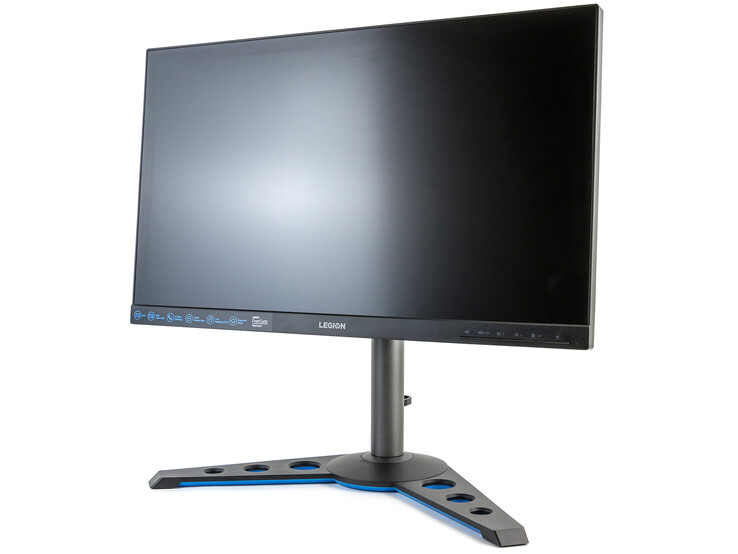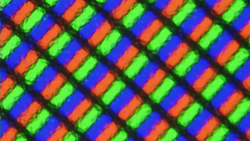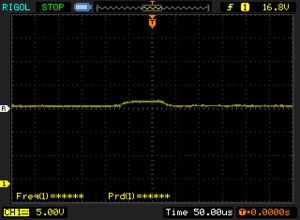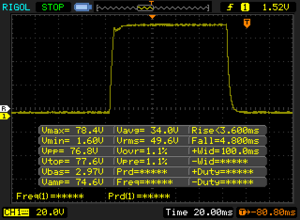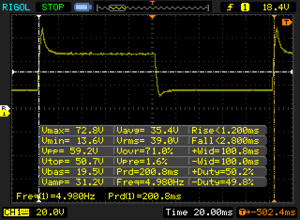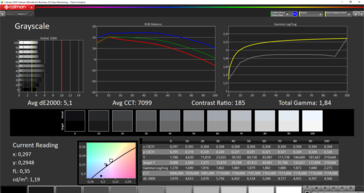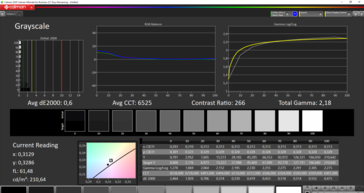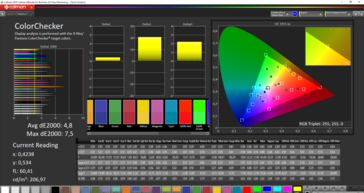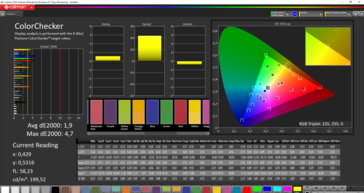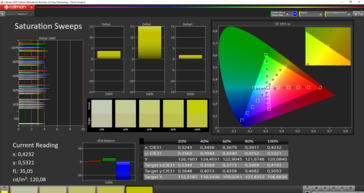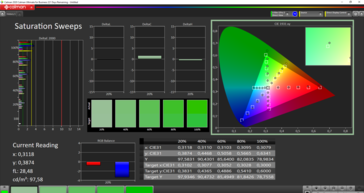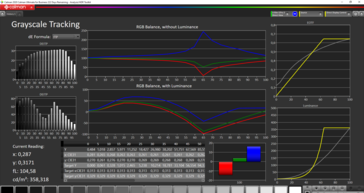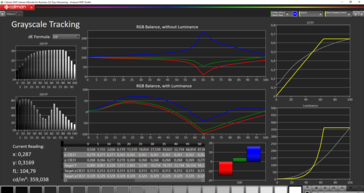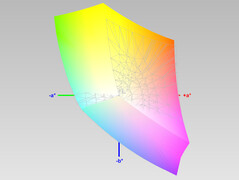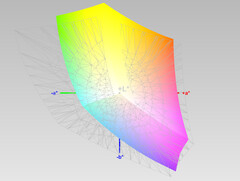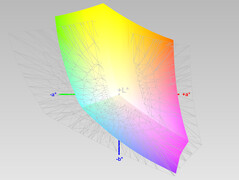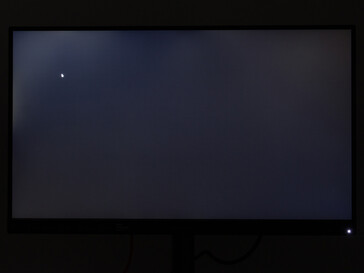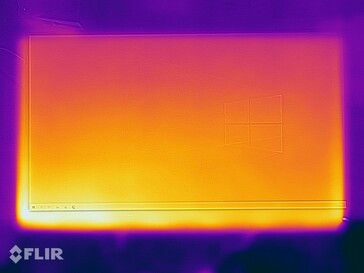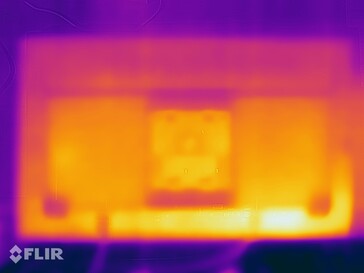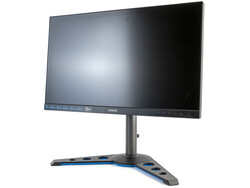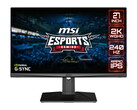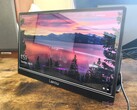Lenovo Legion Y25-25 review: Flexible monitor not only for gamers
With the Legion Y25-25, Lenovo has a gaming monitor in its product range that aims to convince with its Full HD resolution, 240 Hz, AMD FreeSync, and fast response times. At 24.5 inches, it's one of the more compact models in this category.
Lenovo even describes the panel as a professional eSports gaming display. Find out in our review whether the monitor can live up to such high expectations.
Case, connectivity, and handling
The Lenovo Legion Y25-25 gaming monitor is particularly characterized by its ergonomic features. It can be raised by up to 13 centimeters, tilted by -5 to +30 degrees, swiveled by 30 degrees in both directions, and it offers a pivot function that allows the screen to be rotated by 90 degrees. Consequently, the Legion monitor leaves nothing to be desired in terms of ergonomics.
The build quality leaves a solid and clean impression. The included stand in particular impresses with its weight at first touch, and its metal thread is cleanly manufactured. The display can be easily installed using your hands, and it can alternatively be attached to an optional VESA mount.
The port configuration includes a USB-B port, which can be used to connect the Legion Y25-25's integrated USB hub to a computer. The hub features four USB-A 3.0 ports. Two of them are on the left side and the other two at the back. The latter also support Battery Charging 1.2 and can charge smartphones with 5 V and up to 2.4 A, for example.
Besides a DisplayPort (version 1.2), an HDMI 2.0 port is also available for image output. If you don't want to transmit the audio signal digitally over one of the two ports but want to connect an additional solution instead, you'll find an audio jack (3.5 mm) on the side.
Above the jack, a headphone hook is integrated into the case; it can be flipped out, it looks very sturdy, and it even offers enough space for bulky gaming headsets.
The OSD menu of the Legion Y25-25 can be controlled using the six buttons that are integrated into the monitor's frame, and it offers numerous configuration options. However, it's easier to do this using Lenovo's Display Control Center, which offers a few more options.
Display - Lenovo Legion Y25-25 with 240 Hz and AMD FreeSync
The gaming monitor has a display diagonal size of 24.5 inches (62.23 cm) and a quite narrow panel bezel. With an aspect ratio of 16:9 and a resolution of 1920x1080 pixels, the Lenovo Legion Y25-25 offers attractive specs that emphasize its gaming aspirations with a refresh rate of up to 240 Hz as well as AMD FreeSync support.
Lenovo promises a brightness of up to 400 nits. This value wasn't entirely reached in our measurements, and the panel only manages up to 386 cd/m² in some areas. For this, we had to make a lot of changes in the settings and increase contrast to the maximum. Users who activate the sRGB mode for better color reproduction will have to be content with 220 cd/m². Activating HDR mode doesn't result in higher brightness, but the processing of HDR signals is supported.
The black level is slightly increased, which slightly lowers the contrast ratio. This is certainly not optimal for image and video editing, but it's perfectly fine for gaming, since dark sequences are brightened a bit as a result. This effect can be intensified further with a three-stage Black Level Boost.
| |||||||||||||||||||||||||
Brightness Distribution: 89 %
Center on Battery: 386 cd/m²
Contrast: 594:1 (Black: 0.65 cd/m²)
ΔE ColorChecker Calman: 4.8 | ∀{0.5-29.43 Ø4.78}
calibrated: 1.9
ΔE Greyscale Calman: 5.1 | ∀{0.09-98 Ø5}
97.4% sRGB (Calman 2D)
96.73% sRGB (Argyll 1.6.3 3D)
63.45% AdobeRGB 1998 (Argyll 1.6.3 3D)
70.8% AdobeRGB 1998 (Argyll 3D)
96.8% sRGB (Argyll 3D)
72.6% Display P3 (Argyll 3D)
Gamma: 1.84
CCT: 6525 K
In addition to the high refresh rate of 240 Hz, a response time of only 1 millisecond (GtG) is also meant to ensure an optimal gaming performance with the Legion Y25-25. The panel shows fast response times in the test with the oscilloscope, but they are higher than advertised.
However, with a total of 256 grayscale levels, it also depends on which grayscale levels are measured. In our test setting, these are a bit further apart from each other, and the Legion monitor is still very fast. Gamers don't have to expect any drawbacks here.
The fact that Lenovo refrains from using pulse width modulation for brightness control is also positive aspect.
Screen Flickering / PWM (Pulse-Width Modulation)
| Screen flickering / PWM not detected | |||
In comparison: 53 % of all tested devices do not use PWM to dim the display. If PWM was detected, an average of 8111 (minimum: 5 - maximum: 343500) Hz was measured. | |||
Display Response Times
| ↔ Response Time Black to White | ||
|---|---|---|
| 8.4 ms ... rise ↗ and fall ↘ combined | ↗ 3.6 ms rise | |
| ↘ 4.8 ms fall | ||
| The screen shows fast response rates in our tests and should be suited for gaming. In comparison, all tested devices range from 0.1 (minimum) to 240 (maximum) ms. » 22 % of all devices are better. This means that the measured response time is better than the average of all tested devices (20.2 ms). | ||
| ↔ Response Time 50% Grey to 80% Grey | ||
| 4 ms ... rise ↗ and fall ↘ combined | ↗ 1.2 ms rise | |
| ↘ 2.8 ms fall | ||
| The screen shows very fast response rates in our tests and should be very well suited for fast-paced gaming. In comparison, all tested devices range from 0.165 (minimum) to 636 (maximum) ms. » 14 % of all devices are better. This means that the measured response time is better than the average of all tested devices (31.6 ms). | ||
Colors are very saturated out of the box, and they present a cool appearance. Selecting the "Warm" monitor profile reduces these effects, but grayscales remain too bright and still show a slight blue tint. However, calibration can be worthwhile, since it results in almost flawless grayscale levels, and color reproduction is also good. Professional image editing is certainly still not recommended, but the given performance is sufficient for web graphics and hobby photographers.
The color-space coverage of around 97% (sRGB) is only slightly below the manufacturer's specifications.
We like the viewing-angle stability of the Lenovo Legion Y25-25. The IPS panel always reproduces colors consistently. Only when viewing the screen from sharper angles does a slight gray veil cover the image, and there is a noticeable decrease in brightness as well. However, this doesn't happen when you have the display in front of you.
Slight screen bleeding is perceptible in our review sample when the display reproduces a pure black image. Nevertheless, this didn't have a negative visual impact in everyday use or even in dark gaming scenes.
Emissions
The surface temperatures of the Lenovo Legion Y25-25 are absolutely harmless. Although the resulting heat is noticeable, the screen only warms up to 38.1 °C (~101 °F) in the lower left area at the front.
Lenovo estimates power consumption at up to 75 watts. This will be the case when actively using the 240 Hz and HDR content, but the display only consumes around 23 watts in normal operation with 60 Hz. The standby power consumption is even better than what the manufacturer's specifications promise, and it drops to 0.102 watts in a completely deactivated state. If you don't feel like pressing the power button after turning off the computer (active standby mode), the monitor will consume 0.187 watts instead.
Pros
Cons
Verdict - Versatile monitor from Lenovo
With the Legion Y25-25, Lenovo offers a strong gaming monitor that fulfills high requirements as well. Especially in games where high speed and good visibility are important, the Y25-25 is a very good choice. This isn't only because of the high refresh rate and the fast response times, but also because of the many small features that the user can resort to.
The Lenovo Legion Y25-25 meets high standards when it comes to gaming, but it can also be a good addition in the workplace.
The display can be optimally adjusted to the user's needs due to its extensive configuration options. Not only does this affect the panel properties themselves but also the ergonomics in particular. Furthermore, the pivot function is practical as well.
Although the display didn't quite reach the specified brightness in the test, this isn't a problem in everyday use as long as the sun doesn't shine directly upon the screen. There are no reflections due to the matte surface. Officially, the Y25-25 is only certified for FreeSync, but it can also use Nvidia's G-Sync through the DisplayPort.
All in all, this is a strong gaming monitor that users won't regret buying.
Price and availability
At the time of writing, the gaming monitor can be found on Amazon for a discounted price of $269.99. Alternatively, it's also available both in Lenovo's ($329.99) and Best Buy's ($269.99) online stores.





